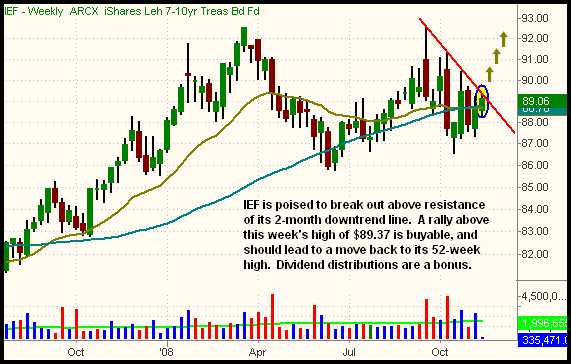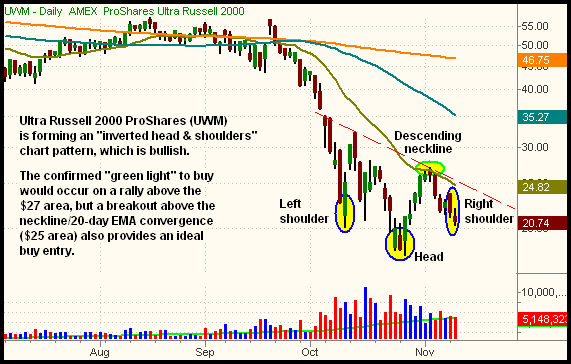|
The Wagner Daily ETF Report For November 12
Stocks followed up Monday's decline with another round of losses yesterday, causing the major indices to give back the rest of their November 7 gains. After opening significantly lower, the main stock market indexes drifted sideways to down throughout the first half of the day. Later in the afternoon, a sudden rally reversed most of the day's losses and lifted the major indices to new intraday highs. However, bullish enthusiasm fizzled out into the close, causing stocks to fall back down. The Dow Jones Industrial Average declined 2.0%, as the S&P 500 and Nasdaq Composite registered identical losses of 2.2%. The small-cap Russell 2000 and S&P Midcap 400 indices shed 2.2% and 2.4% respectively. Acting erratically and showing indecision in the final hour of trading, the main stock market indexes closed between the bottom third to middle of their intraday ranges.
Total volume in the NYSE increased 7% above the previous day's level, while volume in the Nasdaq ticked 14% higher. The losses on higher volume caused both the S&P 500 and Nasdaq Composite to register a bearish "distribution day." It was the third such day of institutional selling in the S&P 500 in recent weeks, and the second in the Nasdaq. When a fledgling rally attempt is under way, the presence of four or more days of higher volume selling in a three to four week period is typically enough to knock out any developing uptrends. But despite yesterday's higher volume losses, it's notable to point out yesterday's trading activity remained well below average levels.
Although we're already long iShares Corporate Bond (LQD), we noticed many other bond ETFs are now positioned to move higher as well. iShares 7-10 year T-bond (IEF) is about to break out above resistance of a downtrend line that has been in place for the past two months. If it does, IEF should rally to test its 52-week high. As shown on the weekly chart below, a move above this week's high of $89.37 will cause IEF to break out:

As we recently mentioned, remember an added benefit of using technical analysis to trade the fixed-income (bond) ETFs is the regular dividend distributions they provide to shareholders. On November 3, 2008, for example, IEF paid a dividend of 32 cents per share. Even though the share price is adjusted to reflect the dividend distributions, the bullish chart patterns still provide a good chance of realizing capital gains, as well as dividends.
Yesterday, we discussed a potential ETF trade setup that involved buying or selling short one of the broad-based ETFs on a breakout above short-term resistance or breakdown below short-term support. But because several of the main stock market indexes gapped down to open right at support of their three-day lows, we held off on selling short. Our concern was the major indices would dip below the obvious resistance levels, then rapidly reverse to fill their downside gaps. We were right about the "fakeout" probe below support of the short-term range, but the bullish reversal didn't come until later in the afternoon. After passing on a short entry into the opening weakness, we instead initiated a new long position in Ultra Russell 2000 ProShares (UWM), right after the stock market started to move higher in the afternoon. With a tight protective stop just below yesterday's low, the entry provided a very positive reward-risk ratio if bullish momentum started to return.
Another reason we were inclined to "dip a toe in the water" on the long side of the market, during the afternoon rally, is the daily chart pattern of UWM. Presently, UWM is forming the right shoulder of a bullish "inverse head and shoulders" pattern on its daily chart. Due to the wild volatility in early October, the left shoulder is a bit funky looking, and the neckline is descending, but the bullish pattern is definitely distinguishable:

Whenever we spot an inverse head and shoulders pattern, we place our initial buy near the bottom of the right shoulder, then add to the position if the price subsequently follows through to rally above the neckline. Scaling into the trade in this manner provides a good reward-risk ratio on the initial entry, then allows for more profit to be realized as additional price confirmation becomes available. With UWM, that equates to an initial buy entry near current levels, with an add above the $27 area. However, in this case, the descending neckline of UWM converges with the 20-day exponential moving average (the beige line). As such, a convincing breakout above the $25 area is nearly as low-risk as waiting for the $27 area to add.
You may be encouraged to know that several of the major indices, quite a few industry sectors, and a plethora of individual stocks are also forming the right shoulders of inverse head & shoulders patterns right now. IF the patterns follow through, we can expect to see solid bullish momentum in the short to intermediate-term. Still, let's not forget the major indices remain stuck near the middle of a choppy, month-long consolidation. Fakeout breakouts and breakdowns are to be expected in such conditions, so don't be surprised if it takes several attempts for the technical chart patterns to "do their thing." That's why we continue to trade with reduced share size.
Open ETF positions:
Long - FXY, LQD, IBB, UWM, DGP
Short - (none)
Deron Wagner is the Founder and Head Trader of both Morpheus Capital LP, a U.S. hedge fund, and Morpheus Trading Group, a trader education firm launched in 2001 that provides daily technical analysis of the leading ETFs and stocks. For a free trial to the full version of The Wagner Daily or to learn about Wagner's other services, visit MorpheusTrading.com or send an e-mail to deron@morpheustrading.com.
|